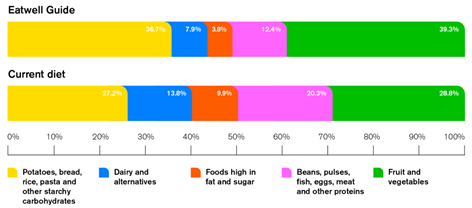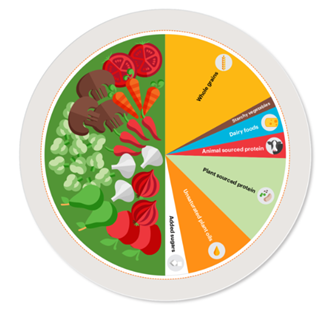What is a healthy diet?
It goes without saying that food lies at the heart of human health. A healthy diet helps prevent malnutrition and non-communicable diseases (NCDs) such as heart disease, cancer and diabetes1. Globally, poor-quality diets are the leading cause of morbidity and mortality2, while NCDs account for 71% of all deaths. Tobacco use, physical inactivity, harmful use of alcohol and unhealthy diets increase the risk of such diseases3.
In terms of the grocery industry, we know customers are also concerned for their health. In a recent dunnhumby survey, 84% of customers expressed an interest for healthy eating and 46% were particularly focused on healthy eating (see previous Covid blog).
In the UK the IGD are working with Sainsbury’s (and other retailers) along with Leeds University with the aim of improving customer diet4. Sainsbury’s have already made 60% of promotions on healthier choices5, while Tesco have committed to increasing sales of healthier food products from 58% to 65% of total sales by 20256. However, any retailer around the world who is willing to stick its neck out for customer health will also need to be aware of its price perception (see blog: healthy diets and unhealthy price perceptions).
In this blog I’ll explore what a nutritionally healthy diet actually is. How is it defined? If retailers and suppliers are to improve the health of their customers, surely there needs to be a clear understanding of a healthy diet is in the first place?
Models for determining a healthy diet
- UK Nutrient Profile Model
From a UK grocery perspective, the most influential model for determining a healthy diet is the UK Nutrient Profile Model. This was originally developed by the Foods Standards Agency in 2005 to provide Ofcom (the UK broadcast regulator) with rules on advertising to children. This model creates a rather complex nutrient profile score based on the nutrient content of 100g of a food or drink (Department of Health, 2011; see Nutrient Profiling Technical Guidance, 2011 for more information; PHE, 2018).
However, there are around 20 different nutrient profile models catered towards different nationalities around the world7, all of which influence pack nutrient information. The main criticism of these models is that they may fail to capture the nutrient density of foods7; they may lack validity (i.e. proof they benefit the customers)8 and may be too strict9. In terms of the UK’s proposed ban on HFSS promotions, this may imply that less healthy options are incorrectly promoted (or vice versa)9. Furthermore, it’s detailed complexity may go over the heads of many less health-conscious customers who may relate more to food groups than nutrients.
- Eatwell Guide
More recently, the UK’s Public Health England (an executive agency to the Department of Health) created the Eatwell Guide 10. The Eatwell Guide provides a customer-friendly representation of how different foods contribute to a healthy diet (see Eatwell Guide visualisation). It moves away from communicating in term of nutrients towards generic food groups. It also provides more easily understood customer aims (e.g. eat five portions of fruit and vegetables a day).
Figure 1 highlights the differences between the current UK diet when compared to the Eatwell recommendations. It suggests that there should be an increase in starchy carbohydrates, fruit & vegetables; together with a decrease in proteins, dairy and High Fat Sugar Salt (HFSS)11.

Figure 1: highlights the difference between UK current diet and the recommended diet11.
- Eat Lancet commission
Perhaps more interestingly is an more recent Eat Lancet commission from 2019 which created the first global benchmark diet to optimise both human health and food production sustainability12. It was created by 20 experts in fields relating to human health and environmental sustainability. Figure 2 shows a summary of the recommendations:

Figure 2: shows what a planetary health plate should look like 13
The commission states that this diet can cope with a predicted population of nearly 10 billion people by 2050 and still stay within a safe operating space on Earth. However, the commission also state that even a small increase in red meat or dairy foods would make this safe space impossible. This model may be more relatable to those customers with a global and sustainable mindset.
Conclusion
When reading across the various definitions of a healthy diet, the generic advice for customers is simple:
- Increase fruit and vegetable (whether fresh, frozen, canned, dried)
- Decrease HFSS products (e.g. biscuits, crisps, chocolates etc)
- Decease red and processed meats
- Decrease dairy (perhaps by increasing dairy alternatives)
However, for retailers and brands, there are multiple questions that remain unanswered when taking a customer first perspective:
- Which aspects of each model do customers prefer?
- How do different models affect HFSS definitions, which may then affect price and promotions?
- How do these models differ from a customer definition (which may also include organics, vegan, allergies) and is it possible to bridge this gap?
- To what extent will customers react negatively, when being advised what to eat?
At the moment, a genuinely personalised healthy diet at scale is not a mainstream reality (but see dnaNudge shop for an interesting next step using customer DNA). However, retailers and brands still have a duty of care to customers and need to continue efforts to improve customer heath.
References
1 who.int/news-room/fact-sheets/detail/healthy-diet
2 Hirvonen, K., Bai, Y., Headey, D., & Masters, W. A. (2020). Affordability of the EAT–lancet reference diet: A global analysis. The Lancet Global Health, 8(1), e59–e66.
3 who.int/news-room/fact-sheets/detail/noncommunicable-diseases
4 igd.com/articles/article-viewer/t/how-to-shift-consumers-to-healthy-and-sustainable-diets/i/29626
5 thegrocer.co.uk/tesco/tesco-announces-new-65-healthy-products-target-as-it-steps-up-action-on-obesity/653889.article
6 thegrocer.co.uk/health/tesco-to-go-ahead-with-hfss-multibuy-ban-despite-government-u-turn/667645.article
7 M. Santos, A.I. Rito, F.N. Matias, R. Assunçai, I. Castanheira & I. Loureiro (2021). Nutrient profile models a useful tool to facilitate healthier food choices: a comprehensive review. Trends Food Science and Technology 110: 120-131
8 Labonte, M.-E., ` Poon, T., Gladanac, B., Ahmed, M., Franco-Arellano, B., Rayner, M., et al. (2018). Nutrient profile models with applications in government-led nutrition policies aimed at health promotion and noncommunicable disease prevention: A systematic review. Advances in Nutrition 9(6): 741–788. https://doi.org/10.1093/ advances/nmy045
9 Jenneson, V. & Morris, M.A. (2021) Data considerations for the success of policy to restrict in-store food promotions: a commentary from a food industry nutritionist consultation. Nutrition Bulletin, 46(1), 40–51. doi.org/10.1111/nbu.12486
10 gov.uk/government/publications/the-eatwell-guide/the-eatwell-guide-how-to-use-in-promotional-material
11 Access To Nutrition Initiative (ATNI): UK Retailer Index May 2022. accesstonutrition.org/the-indexes/uk-retailer-index-2022/
12 Willett, W., Rockström, J., Loken, B. et al. (2019). Food in the Anthropocene: the EAT–Lancet Commission on healthy diets from sustainable food systems. Lancet, 393 (2019): 447-492
13 eatforum.org/eat-lancet-commission/eat-lancet-commission-summary-report/
TOPICS
The latest insights from our experts around the world




